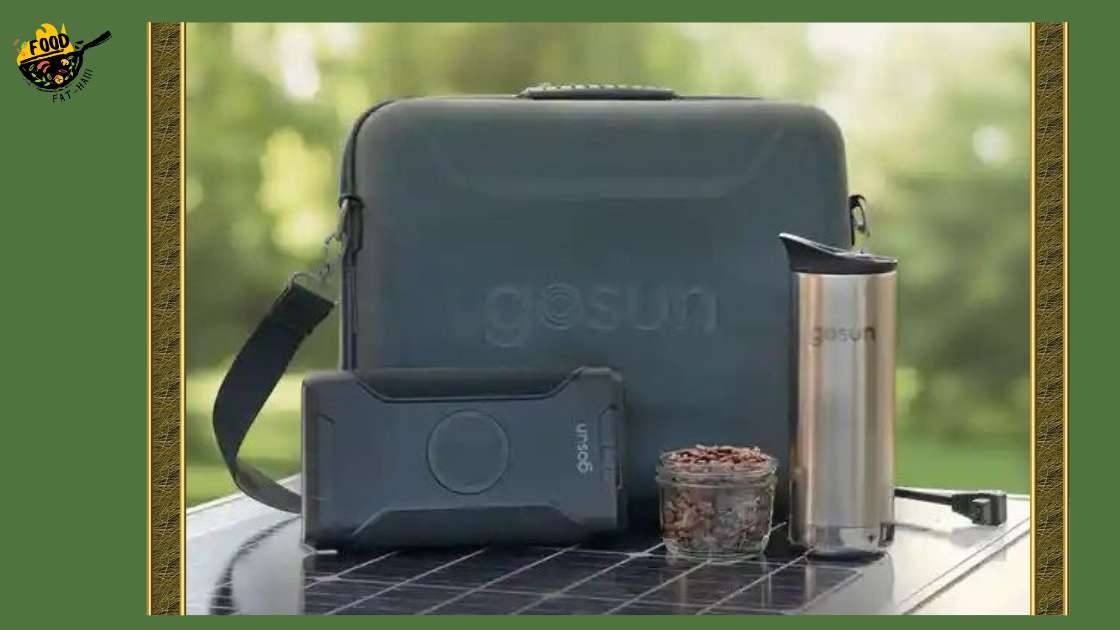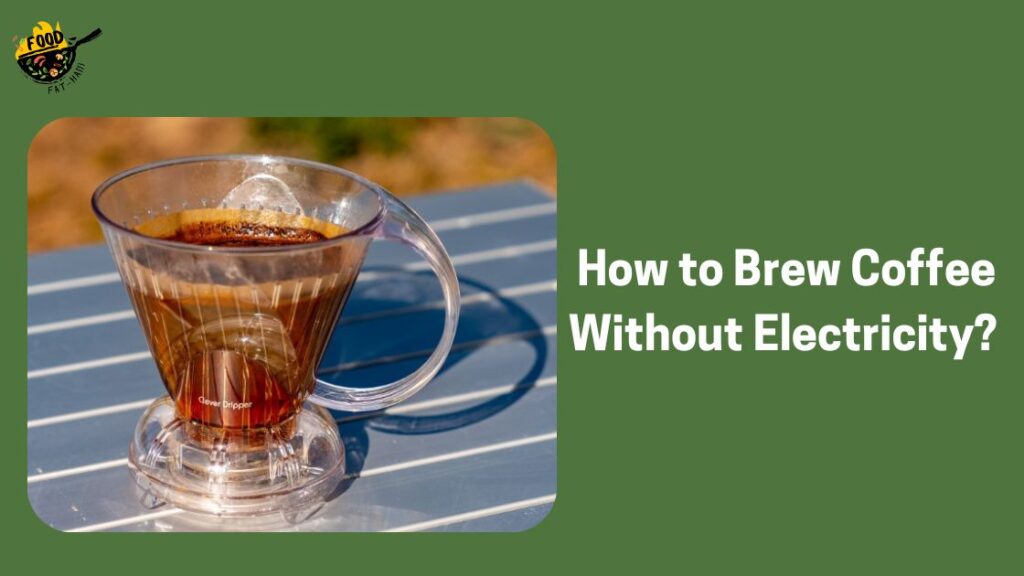To make or brew coffee without electricity, use a stovetop coffee maker or a French press on a gas stove or over a campfire. Coffee is a beloved morning ritual for many people, providing a much-needed caffeine kick to start the day.
Table of Contents
ToggleBut what happens when the power goes out or you find yourself without electricity? Don’t worry, you can still enjoy a delicious cup of joe by using alternative brewing methods. We will explore how to brew coffee without electricity, whether you’re at home or in the great outdoors.
With a few simple tools and a heat source like a stovetop or campfire, you’ll be sipping on a hot, aromatic cup of coffee in no time. So let’s dive in and discover how to satisfy your caffeine cravings without relying on electricity.
Camping Coffee Brewing Methods
Discover the ultimate guide to brewing coffee while camping, without the need for electricity. Learn about various methods that are practical, and efficient, and ensure a delicious cup of joe, even in the great outdoors.

The Cowboy Method
If you find yourself camping without electricity but craving a cup of joe, don’t worry! You can still enjoy a delicious and satisfying cup of coffee using the cowboy method. This traditional brewing method involves a simple process that allows you to brew coffee over an open fire, giving you that authentic camping experience.
Here’s a step-by-step guide to making coffee using the cowboy method:
- Bring water to a boil: Start by heating water in a kettle or pot over the fire until it reaches a rolling boil.
- Remove from heat: Once the water is boiling, remove it from the heat source and let it sit for about 30 seconds to cool slightly.
- Add coffee grounds: Measure out your desired amount of coarsely ground coffee and add it directly to the water. As a general guide, use 2 tablespoons of coffee for every 6-8 ounces of water.
- Stir and steep: Give the mixture a good stir to ensure the coffee grounds are thoroughly incorporated. Let it steep for about 4 minutes, allowing the flavors to develop.
- Settle the grounds: To settle the coffee grounds, you can lightly tap the side of the pot. This will help them sink to the bottom.
- Pour and enjoy: Carefully pour the coffee into cups or mugs, being sure to leave behind any remaining grounds at the bottom of the pot. Add sugar, cream, or any other desired additions, and savor the rich and robust flavor of your campfire-brewed coffee.
The French Press Technique
Another popular method to brew coffee without electricity while camping is using the French press technique. This method allows you to brew a strong and flavorful cup of coffee with minimal equipment.

Here’s a step-by-step guide to brewing coffee using a French press:
- Heat water: Begin by heating water in a kettle or pot over the campfire until it reaches the ideal temperature of around 200°F (93°C).
- Grind coffee beans: While the water is heating, grind your coffee beans to a coarse consistency. Aim for a grind similar to sea salt.
- Add coffee grounds: Measure out the appropriate amount of coffee grounds for your desired strength and pour them into the French press.
- Pour water and steep: Slowly pour the hot water over the coffee grounds, ensuring they are fully immersed. Place the lid on the French press but do not press down the plunger just yet. Allow the coffee to steep for approximately 4 minutes to ensure optimal flavor extraction.
- Plunge and serve: After 4 minutes, gradually press down the plunger, using gentle and steady pressure. This will isolate the grounds from the brewed coffee. Pour the coffee into cups or mugs and enjoy your flavorful French press coffee.
The Pour-Over Method
The pour-over method is a versatile and lightweight coffee brewing technique that is ideal for camping. All you need is a pour-over coffee maker, paper filters, ground coffee, a kettle, and hot water. It allows you to have control over the brewing process and produces a clean and flavorful cup of coffee.
Here’s a step-by-step guide to brewing coffee using the pour-over method:
- Boil water: Start by boiling water in a kettle or pot over the fire until it reaches the ideal temperature of around 200°F (93°C).
- Prepare the pour-over coffee maker: Place a paper filter in the pour-over coffee maker, ensuring it is properly seated and not folded. Set the coffee maker on top of your cup or mug.
- Rinse the filter: Pour some hot water over the paper filter to rinse it and remove any residual flavors. This will also preheat your cup or mug.
- Add coffee grounds: Measure out the desired amount of coffee grounds for your preferred strength and pour them into the filter.
- Begin pouring: Start pouring hot water evenly over the coffee grounds, starting from the center and spiraling outward. Use a slow and steady pour to allow the coffee to bloom and extract the flavors.
- Allow the coffee to drip: Let the coffee gradually drip through the filter into your cup or mug. Adjust your pouring speed to control the extraction rate.
- Serve and enjoy: Once all the water has dripped through the filter, remove the pour-over coffee maker and discard the paper filter. Add any desired additions, then sit back and savor your freshly brewed pour-over coffee.
By mastering these camping coffee brewing methods, you can enjoy a delicious and energizing cup of coffee even without electricity. So next time you’re out in the wilderness, embrace the simple pleasures of brewing your own coffee and start your day right amidst nature’s beauty.
Alternative Heat Sources For Coffee Brewing
Discover alternative heat sources to brew coffee without electricity. From propane stoves to solar-powered gadgets, explore creative methods to enjoy a hot cup of joe anywhere, anytime.
In situations where you don’t have access to electricity, there are several alternative heat sources you can use to brew your coffee. Whether you’re out in the wilderness camping, experiencing a power outage, or simply looking to try something different, these methods will ensure you can enjoy a hot cup of joe.
Let’s explore three popular options: using a campfire or bonfire, harnessing solar energy, and utilizing stove-top methods.
Using A Campfire Or Bonfire:
- If you find yourself in the great outdoors, building a fire can provide an excellent source of heat for brewing coffee.
- First, gather dry twigs, small branches, and tinder to start your fire.
- Use a fire pit, fire ring or create a circle of rocks to contain the fire.
- Ignite the tinder and slowly add the twigs and branches, allowing the fire to grow.
- Bring a pot or kettle, filled with water, to a boil over the fire.
- Once the water is boiling, remove it from the flames and add coffee grounds.
- Let the coffee steep for a few minutes before straining it into your cup.

Solar Energy Coffee Brewing:
- Take advantage of the sun’s rays by using solar energy to brew your coffee.
- Begin by using a heat-resistant glass container or a mason jar.
- Place your desired amount of coffee grounds into the container.
- Fill the container with cold water and stir well to ensure the grounds are fully saturated.
- Find a sunny spot, preferably outdoors, and set the container there for a few hours.
- Allow the sun to heat the water and steep the coffee grounds over time.
- When you’re satisfied with the strength of your coffee, strain it into your cup.
Stove-Top Methods For Coffee Lovers:
- If you have access to a propane or gas stove, there are several stove-top methods for brewing coffee.
- The most common is using a stovetop espresso maker, also known as a Moka pot.
- Fill the lower chamber with water and the filter basket with coffee grounds.
- Screw on the top chamber tightly and place the pot on the stove over low heat.
- As the water heats up, steam pressure builds and pushes the water through the grounds.
- Eventually, the brewed coffee will collect in the top chamber for you to pour and enjoy.
- Another option is using a percolator, which operates by cycling hot water repeatedly through the coffee grounds.
- Fill the percolator with water, add coffee grounds to the upper chamber, and place it on the stove.
- Allow the water to boil, and let the percolator do its work until you achieve the desired strength.
Now that you know these alternative heat sources, you can confidently brew coffee even without electricity. Whether you’re sipping by a campfire, harnessing the sun’s energy, or utilizing a stove-top method, these strategies ensure you never have to go without your favorite morning beverage.
Get creative, embrace the adventure, and enjoy your cup of coffee!
Cold Brew Coffee Making Techniques
Learn how to make cold brew coffee without electricity using simple techniques for delicious, refreshing coffee anytime and anywhere. Discover alternative methods that require minimal equipment and enjoy the smooth, bold flavors of cold brew without the need for a power source.

The Cold Drip Method
- Cold-drip coffee is made by slow-dripping cold water over coffee grounds.
- This method ensures a smooth and flavorful cup of coffee, with low acidity and bitterness.
- The equipment needed includes a cold drip tower or a DIY setup with two containers and a dripping mechanism.
Follow these steps to make cold drip coffee:
- Grind your coffee beans to a texture that resembles rough sand, which is a medium-coarse consistency.
- Add the coffee grounds to the top container of the cold drip tower or in your DIY setup.
- Slowly pour cold water into the top container, allowing it to gradually drip through the coffee grounds.
- The coffee will collect in the bottom container, ready to be enjoyed over ice or refrigerated for later.
The Immersion Method
- The immersion method entails soaking coffee grounds in cold water for a prolonged period, usually between 12 to 24 hours.
- This method produces a full-bodied and bold cup of coffee, with a slightly higher acidity.
Here’s how to make cold brew coffee using the immersion method:
- Coarsely grind your coffee beans.
- Place the coffee grounds in a container and add cold water, ensuring that all the grounds are fully saturated.
- Stir the mixture gently to ensure even extraction.
- Cover the container and allow it to steep in the refrigerator for a minimum of 12 hours, or up to 24 hours for a more intense brew.
- After steeping, strain the coffee using a fine-mesh sieve or a coffee filter to separate the grounds from the liquid.
- The resulting cold brew concentrate can be diluted with water or milk and served over ice.
The Japanese Iced Coffee Method
- The Japanese iced coffee method involves brewing coffee directly over ice, creating a smooth and aromatic cup in a shorter time.
- This method preserves the delicate flavors and aromas typically lost during the cold brewing process.
Follow these steps to make Japanese iced coffee:
- Grind your coffee beans to a texture that is between medium and coarse, similar to the consistency of rough sand or slightly smoother than a French press grind.
- Place a filter in your drip brewer and fill it with coffee grounds.
- Prepare a cup filled with ice cubes.
- Brew hot water and pour it over the coffee grounds in the drip brewer, allowing it to drip directly onto the ice cubes.
- The hot water instantly cools, brewing the coffee directly onto the ice, resulting in a well-extracted, chilled cup of coffee.
- Stir to ensure the ice is melted and enjoy the refreshing flavor of Japanese iced coffee.
Remember, each of these methods offers a unique way to make delicious cold-brew coffee without the need for electricity. Try out various brewing methods to determine which one aligns best with your taste preferences. Happy brewing!
Converting Coffee Brewing Equipment For Non-Electric Use
Learn how to make coffee without electricity by converting your coffee brewing equipment for non-electric use. Discover new ways to enjoy a hot cup of coffee in any situation.
If you find yourself without electricity but still craving a delicious cup of coffee, don’t fret! With a few modifications to your existing brewing equipment, you can enjoy a piping hot cup of joe even without power. Below, we’ll explore how to convert different types of coffee makers for non-electric use.
Modifying A Drip Coffee Maker:
- Remove the power cord from the drip coffee maker.
- Place the coffee maker on a stovetop or use a portable gas burner.
- Fill the reservoir with water and place the coffee grounds in the filter basket.
- Heat the stovetop or portable burner to the desired temperature.
- Allow the coffee to brew as the water heats up and trickles through the grounds.
- Once brewed, carefully pour the coffee from the carafe into your mug.
Adapting An Espresso Machine:
- Disconnect the espresso machine from the power source.
- Fill the machine’s reservoir with water.
- Heat a stovetop or portable gas burner and place the espresso machine on top.
- Allow the water to heat up and create pressure within the machine.
- Add your ground coffee to the portafilter and lock it in place.
- Once the water is heated, manually pump the handle to force the water through the coffee grounds, similar to using a lever espresso machine.
- Enjoy your homemade espresso shot or use it as a base for other coffee beverages.
Alternative Coffee Makers For Cold Brew:
- Choose a cold brew coffee maker specifically designed for non-electric use.
- Add your desired amount of coarsely ground coffee to the filter or mesh basket.
- Pour cold water into the reservoir or container.
- Allow the coffee to steep for the recommended time, usually between 12 to 24 hours.
- Once the steeping is complete, remove the filter or mesh basket and discard the coffee grounds.
- Serve the cold brew coffee over ice or dilute it with water or milk to your preference.
With these simple modifications, you can continue to enjoy your favorite brewed coffee without relying on electricity. So the next time you experience a power outage or find yourself in a remote location, don’t worry—your caffeine fix is still within reach.
Embrace the creativity and adaptability of the coffee brewing process and savor each sip of your homemade, non-electric brewed coffee.
Diy Coffee Brewing Gadgets For Off-Grid Brewing
Discover the ultimate guide to brewing coffee off the grid with DIY coffee gadgets. Learn how to make a delicious cup of coffee without electricity using innovative brewing methods.
If you find yourself in a situation where electricity is unavailable or you simply prefer a more eco-friendly brewing method, there are several ingenious gadgets that can help you make a delicious cup of coffee off the grid. These DIY coffee brewing gadgets are portable, easy to use, and perfect for those who love to enjoy their coffee even when traditional methods aren’t an option.
Bottle Top Coffee Filters:
- Upside-Down Water Bottle Filter: Turn a regular plastic water bottle upside down and create a small hole in the cap. Fill the bottle with water, add your coffee grounds, and let it steep. When you’re ready, flip the bottle over onto a cup, and the coffee will filter through the hole in the cap, leaving you with a freshly brewed cup of java.
- Reusable Coffee Filters: Utilize reusable coffee filters specifically designed to fit on top of bottles. These filters are made from fine mesh or fabric and allow you to brew coffee directly into your favorite water bottle or thermos. They are washable, durable, and an excellent option for reducing waste.
Portable Coffee Presses:
Invest in a portable French press mug. These mugs combine the convenience of a travel mug with a built-in French press mechanism. Simply add coffee grounds and hot water, let it steep for a few minutes, and then press the plunger down to separate the brewed coffee from the grounds.
AeroPress is a compact and versatile coffee brewing device that can easily fit in your backpack. This gadget employs air pressure to extract flavors from coffee grounds. It is lightweight, easy to clean, and allows you to experiment with different brew methods to customize your coffee to perfection.
Hand-Powered Coffee Grinders:
Embrace the art of hand grinding your coffee beans with a manual burr grinder. These grinders use adjustable burrs to crush coffee beans consistently, resulting in a uniform grind size. They are compact, user-friendly, and operate without the need for electricity.
Opt for a travel-sized hand grinder for on-the-go coffee grinding. These mini grinders are specifically designed for portability and can be easily packed in your backpack. Despite their compact size, they still deliver a consistent and fresh grind, ensuring a flavorful cup of coffee.
By using these DIY coffee brewing gadgets, you can enjoy a satisfying cup of coffee without relying on electricity. Whether you’re camping, traveling, or simply looking for an alternative brewing method, these portable and off-grid-friendly tools will keep you caffeinated and satisfied.
So, the next time you find yourself without power, don’t fret—just grab your favorite gadget and brew up a flavorful cup of coffee wherever you are.
Historical Methods Of Brewing Coffee Without Electricity
Discover the intriguing historical methods of brewing coffee without electricity, exploring creative alternatives for making your favorite caffeinated beverage using traditional techniques. Embrace the charm of ancient brewing practices, and savor the rich aroma and taste of coffee the old-fashioned way.
It’s fascinating to explore the various methods used throughout history for brewing coffee without electricity. From Ethiopian coffee ceremonies to Turkish coffee-making techniques and even ancient Egyptian coffee making, the ingenuity of these cultures shines through. Let’s examine each method in detail.
Ethiopian Coffee Ceremony:
- Ethiopian coffee ceremonies are a central part of their cultural traditions.
- The ceremony includes roasting the coffee beans over an open flame, manually grinding them, and then brewing the coffee in a traditional clay pot known as a jebena.
- The aroma fills the air as the coffee is brewed, and it’s served in small cups called sini.
- The Ethiopian coffee ceremony is not just about the coffee itself but also represents a time for socializing, storytelling, and connecting with others.
Turkish Coffee Making Techniques:
- Turkish coffee is renowned for its robust and intense flavor profile.
- The preparation process involves using finely ground coffee beans and a special pot called a cezve.
- The coffee is brewed by combining water, finely ground coffee, and sugar (optional) in the cezve and simmering it over low heat.
- The result is a thick and intense coffee that is often served in small cups.
- Turkish coffee making is considered an art form, and the preparation process is often accompanied by a sense of tradition and ritual.
Ancient Egyptian Coffee Making:
- In ancient Egypt, coffee was made using a process similar to steeping tea.
- The coffee beans were ground into a coarse powder and mixed with hot water in a pot.
- The mixture was then left to steep for a period of time, allowing the flavors to infuse.
- The final step involved pouring the coffee from a height to create a frothy layer on top.
- This method of coffee making in ancient Egypt demonstrates their innovative approach to brewing without the use of electricity.
These historical methods of brewing coffee without electricity exemplify the creativity and resourcefulness of different cultures. Whether it’s the Ethiopian coffee ceremony, Turkish coffee-making techniques, or the ancient Egyptian coffee-making process, each method offers a unique and flavorful experience.
By embracing these traditions, we can expand our appreciation for coffee and its cultural significance.
Brewing Coffee Without Electricity During Emergencies
During emergencies, you can still enjoy a hot cup of coffee even without electricity. This article reveals clever ways to brew coffee without power, ensuring you stay caffeinated in challenging situations.
During emergencies, being able to brew a cup of coffee without electricity can provide a sense of normalcy and comfort. Whether you’re experiencing a power outage at home or find yourself in a natural disaster situation, having alternative coffee brewing methods can be a game-changer.
In this section, we’ll discuss emergency coffee kits, portable coffee solutions, and coffee brewing in natural disasters.
Emergency Coffee Kits
An emergency coffee kit is a pre-packed collection of essential items needed to brew coffee when electricity is not available. These kits are designed for convenience and include items such as:
- Manual coffee grinder: A portable and hand-operated coffee grinder allows you to grind your coffee beans without relying on electricity.
- Chemex or French Press: These brewing devices are excellent choices for emergency situations as they do not require electricity. Both methods produce delicious coffee by steeping the grounds in hot water.
- Portable stove or camping burner: A compact stove or camping burner can be used to heat water for brewing coffee. Opt for a propane or butane-powered option for versatility.
- Coffee beans and filters: Stock your emergency coffee kit with a supply of your favorite coffee beans and filters. Choose durable filters like reusable metal filters or biodegradable paper filters.
With an emergency coffee kit at your disposal, you can enjoy a flavorful cup of coffee even during challenging situations.
Portable Coffee Solutions
When it comes to brewing coffee without electricity on the go, portable coffee solutions are the way to go. These options are ideal for camping trips, outdoor adventures, or simply when you’re away from home and don’t have access to electricity.
Consider the following portable coffee solutions:
- Single-serve coffee makers: Compact and convenient, single-serve coffee makers like AeroPress or portable espresso machines are perfect for brewing coffee on the go. These devices rely on manual pressure or hot water to extract the coffee flavors.
- Instant coffee: While it may not offer the same taste experience as freshly brewed coffee, instant coffee is an easy and lightweight option when electricity is not available. Simply mix it with hot water, and you’ll have a quick coffee fix.
- Ready-to-drink coffee: Pre-packaged cold brews or canned coffee drinks are excellent choices if you prefer a ready-to-drink option. They require no preparation and can be enjoyed straight from the container.
Portable coffee solutions offer flexibility and convenience, allowing you to indulge in your caffeine cravings even without electricity.
Coffee Brewing In Natural Disasters
Natural disasters can disrupt the power supply for an extended period, making it crucial to know alternative coffee brewing methods. Here are some considerations for brewing coffee in natural disasters:
- Camping coffee percolator: A coffee percolator is a traditional and reliable way to brew coffee during natural disasters. These stovetop devices use the power of boiling water and gravity to create a rich cup of coffee.
- Solar-powered coffee makers: Solar-powered coffee makers utilize the energy from the sun to heat water for brewing coffee. These eco-friendly options are particularly useful in areas with prolonged sun exposure.
- Cold brew concentrate: Prepare cold brew concentrate in advance and store it safely for emergencies. This concentrated coffee can be diluted with hot water or enjoyed as a refreshing iced coffee.
- Community resources: In some cases, community centers or relief shelters may have access to generators or alternative power sources. Check with local authorities to see if coffee brewing facilities are available at such locations.
When facing natural disasters, having a backup plan for coffee brewing can help maintain morale and provide a much-needed boost of energy.
With these emergency coffee alternatives, you can ensure that your caffeine fix is never compromised, even when electricity is unavailable. Stay prepared, stay caffeinated!
Innovations In Non-Electric Coffee Brewing
Discover the latest advancements in non-electric coffee brewing methods and learn how to brew a delicious cup of coffee without relying on electricity. Explore innovative techniques that will satisfy your caffeine cravings even in the absence of power.
Are you a coffee lover who wants to enjoy a fresh cup of java even during power outages or camping trips? Don’t worry! With innovative non-electric coffee brewing methods, you can savor the rich flavors of your favorite coffee anytime, anywhere.
In this section, we’ll explore some exciting alternatives to electric coffee machines, from external heat sources to alternative energy appliances to sustainable coffee brewing technologies. So, let’s dive in and discover the fascinating world of coffee brewing without electricity!
External Heat Sources For Coffee Machines:
- Propane Stove: A propane stove is a popular choice among outdoor enthusiasts to brew coffee without electricity. Simply place your trusty coffee maker on top of the stove and let the flames generate the heat required to brew your perfect cup of coffee.
- Campfire: Embrace the classic camping experience by brewing coffee over a campfire. Place your coffee pot on a grill or use a specialized campfire coffee pot. The flames provide the necessary heat while infusing your coffee with that distinct smoky flavor.
- Solar Energy: Harness the power of the sun by using a solar stove or solar coffee maker. These innovative appliances use solar panels to convert the sun’s rays into heat for brewing coffee. Enjoy eco-friendly, off-grid coffee brewing with the help of renewable energy.
Alternative Energy Coffee Appliances:
- Stovetop Espresso Makers: Also known as Moka pots, stovetop espresso makers are a traditional and efficient way to brew strong, flavorful coffee. These portable appliances use steam pressure to force water through coffee grounds, producing a robust cup of espresso-like coffee.
- Manual Coffee Grinders: Take control of your coffee brewing process with a manual coffee grinder. These compact and travel-friendly devices allow you to grind your coffee beans by hand, ensuring a fresh and consistent grind every time. Combine your manual grinder with any non-electric brewing method for a delightful coffee experience.
- French Press: The French press, or plunger pot, is a beloved coffee brewing method that requires no electricity. Simply add coffee grounds and hot water, let it steep, and then press down the plunger to separate the brewed coffee from the grounds. Experience a smooth and full-bodied cup of coffee with the French press’s timeless simplicity.
Coffee Brewing Technologies For Sustainable Living:
- Aeropress: This innovative coffee brewing device uses air pressure to quickly extract the flavors from coffee grounds. With its compact design and versatility, the Aeropress is an excellent choice for eco-conscious coffee enthusiasts who desire a perfect cup of coffee without electricity.
- Pour Over Coffee Drippers: The pour-over method relies on gravity and a slow, careful pouring technique to brew coffee. Choose a manual, non-electric pour-over coffee dripper and enjoy the purest flavors and aromas of your favorite beans. This environmentally friendly brewing technique minimizes waste while providing a rich coffee experience.
- Cold Brew: Perfect for hot summer days or those who prefer less acidity, cold brew coffee requires no heat or electricity. By steeping coffee grounds in cold water for an extended period, usually around 12-24 hours, you can create a smooth and refreshing cup of coffee with low bitterness.
Now that you’re familiar with these innovations in non-electric coffee brewing, you can enjoy a flavorful cup of coffee regardless of the circumstances. Embrace sustainability, portability, or simply the joy of experimenting with different brewing methods. Happy brewing!
Frequently Asked Questions On How To Brew Coffee Without Electricity
Can You Make Coffee At Home Without The Machine?
Yes, it is possible to make coffee at home without a machine.
How Do You Make Hot Coffee Without A Stove?
To make hot coffee without a stove, you can use a coffee maker that runs on electricity or a single-serve coffee maker.
How Do You Make Ground Coffee Manually?
To make ground coffee manually, grind the coffee beans using a grinder or mortar and pestle until you achieve your desired consistency.
How Do You Use Ground Coffee Without Equipment?
To use ground coffee without equipment, simply mix the coffee with hot water and let it steep.
Conclusion
Coffee lovers who find themselves without electricity can still indulge in their favorite beverage with these easy and practical methods. By harnessing the power of heat and manual brewing techniques, you can enjoy a delicious cup of coffee even when the power is out.
Whether it’s using a stovetop espresso maker, a French press, or a pour-over method, there are plenty of options to suit every preference. Get creative and try out different methods to find your perfect cup of coffee. Remember to grind your beans just before brewing, use the right water temperature, and experiment with different brewing times to achieve your desired flavor.
Don’t let a lack of electricity stop you from enjoying the simple pleasure of a steaming cup of coffee. Embrace these alternative brewing techniques and savor the rich aromas and flavors that a good cup of coffee has to offer.



